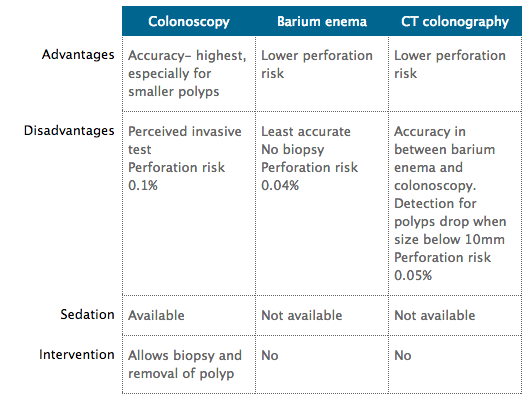All the different tests to examine the colon requires proper cleansing of the colon. There are 3 different ways to examine the colon: colonoscopy, barium enema and computer tomography (CT) colonography (also know as virtual colonoscopy).
Kolonoskopi
Kolonoskopi is the gold standard for examination of the colon. This entails inserting a flexible tube through the anus and advancing it up along the rectum and colon until it reaches the beginning.
Kolonoskopi is usually done under sedation though some patients opt to be awake and watch the entire proceeding. The major advantage of colonoscopy is that it is not just a diagnostic procedure, but it also allows for removal of polyps and to take tissue samples for testing.
Most people are fearful of colonoscopy because they feel that it is a very invasive procedure and are concerned about pain. Most patients do not feel any pain or even remember about the procedure after the they wake up from sedation. The most feared complication that may occur is that of perforation where the scope results in damage and a break in the colon wall. If that happens, surgery is usually required to rectify it. The risk is usually less than 0.1%.
Barium Enema
Barium enema is another way to examine the colon. This is performed by a radiologist who first inserts a tube through the anus. A bag of white liquid (barium) is then poured into the colon through the tube. The patient is rotated so that the barium can flow around the colon. The bag is then dropped to the floor and the barium allowed to flow out. Air is then pumped in through the tube to distend the colon and x-ray images are taken with the patient in different positions.
There is no sedation given for barium enema.
CT Colonography (also known as Virtual Kolonoskopi)
The latest available technique to examin the colon is CT colonography or virtual colonoscopy. The patient also has to have bowel preparation. At the time of the investigation, the radiologist will insert a tube into the rectum via the anus. One to 1.5 litres of air will be pumped in to inflate and distend the colon. The patient will lie down on his back in the CT scanner, an intravenous injection given and the scan will be done. The patient will then lie prone on his tummy and the process repeated. The virtual image of the colon is then produced using computer software.

CEA (Carcino-Embryonic Antigen)
This is a blood test that is commonly used as part of health screening to screen for colon cancer. This test has a sensitivity and specificity of only about 70%. What this means is that it is abnormal in only 70% of patients, while 30% of cancer patients might have a normal CEA level, giving a false sense of security.
On the other hand, people with an abnormally high level of CEA does not mean that they definitely have colon or rectal cancer. It just means that they need further investigations. A high level of CEA could arise due to both cancerous conditions (cancer of colon, rectum, stomach, lung etc) and non-cancerous conditions such as smoking, lung infection, colon infection etc.
Stool occult blood test
Stool occult blood test is a test designed to detect presence of blood traces in the stools. This is to pick up blood that is otherwise not seen by the naked eye.
This test involves taking small sample to stools and sending it fresh (preferably within 48 hours).
The test is based on the assumption that if there any large polyps or cancer, it would bleed as the stools passes next to it. As this blood would have been mixed into the stools when it is passed out, it can no longer be seen with the naked eye. The accuracy depends on the different type of tests used to analyse the stools for blood and is in the region of 70-85%. Some of the older test requires abstinence from meat and other food for up to 3 days before the test and is very inconvenient. Unnecessary in delay or wrong storage of the stool sample prior to storage will also decrease the accuracy. What this means is that up to 30% of patients with colon and rectum cancer will have a negative result and be missed.
This test is more suited for population screening as it is cheaper and more convenient. This is not a diagnostic test for colon cancer. It is not for someone who already sees blood in the stools. It is just a warning indicator to go for a more complete examination of the colon.


